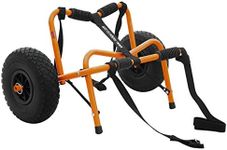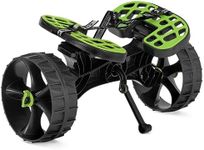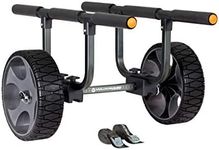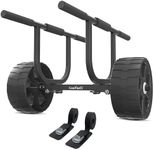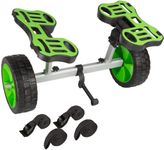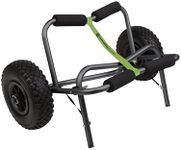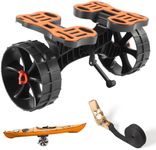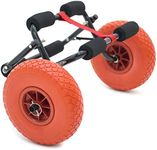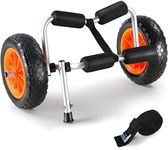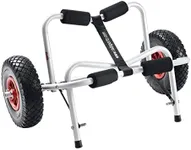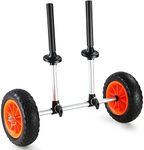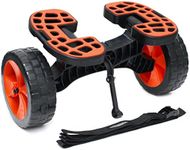Buying Guide for the Best Kayak Carts
Choosing the right kayak cart can make transporting your kayak much easier and more efficient. A kayak cart is a wheeled device that helps you move your kayak from your vehicle to the water without having to carry it. When selecting a kayak cart, it's important to consider several key specifications to ensure you get the best fit for your needs. Understanding these specifications will help you make an informed decision and find a cart that suits your kayak and your typical usage scenarios.Weight CapacityWeight capacity refers to the maximum weight the kayak cart can support. This is important because you need a cart that can handle the weight of your kayak plus any additional gear you might have inside it. Kayak carts typically have weight capacities ranging from 100 to 300 pounds. If you have a lightweight kayak and minimal gear, a cart with a lower weight capacity will suffice. However, if you have a heavier kayak or plan to carry a lot of gear, opt for a cart with a higher weight capacity to ensure it can handle the load without breaking or becoming unstable.
Frame MaterialThe frame material of a kayak cart affects its durability, weight, and resistance to corrosion. Common materials include aluminum, stainless steel, and plastic. Aluminum is lightweight and resistant to rust, making it a good choice for frequent use in wet environments. Stainless steel is more durable and can handle heavier loads but is also heavier. Plastic frames are lightweight and affordable but may not be as durable as metal options. Consider how often you will use the cart and in what conditions to choose the right frame material for your needs.
Wheel TypeThe type of wheels on a kayak cart can impact its performance on different terrains. There are generally two types of wheels: pneumatic (air-filled) and solid. Pneumatic wheels provide better shock absorption and are ideal for rough or uneven terrain, such as sandy beaches or rocky paths. Solid wheels, on the other hand, are puncture-proof and require less maintenance, making them suitable for smooth surfaces like paved roads or grassy areas. Think about the typical terrain you will be traversing to determine which wheel type is best for you.
AdjustabilityAdjustability refers to the ability to modify the cart to fit different sizes and shapes of kayaks. Some carts have adjustable width and height to accommodate various kayak dimensions. This is important if you have multiple kayaks or plan to upgrade in the future. An adjustable cart can provide a more secure fit and better stability during transport. If you have a specific kayak, make sure the cart can be adjusted to fit it properly. If you have multiple kayaks or anticipate changes, an adjustable cart offers more versatility.
PortabilityPortability is about how easy it is to transport and store the kayak cart itself. Some carts are foldable or have removable parts, making them easier to pack in your vehicle or store when not in use. This is particularly important if you have limited storage space or need to carry the cart over long distances. Look for a cart that is lightweight and compact if portability is a priority for you. If you have ample storage space and don't mind a bit of extra weight, a more robust cart might be a better option.
Ease of AssemblyEase of assembly refers to how simple it is to set up and take down the kayak cart. Some carts come fully assembled, while others require some assembly. A cart that is easy to assemble and disassemble can save you time and frustration, especially if you need to set it up frequently. Look for carts with clear instructions and minimal parts if you prefer a hassle-free setup. If you don't mind spending a bit more time on assembly, you might find that more complex carts offer additional features or better performance.
